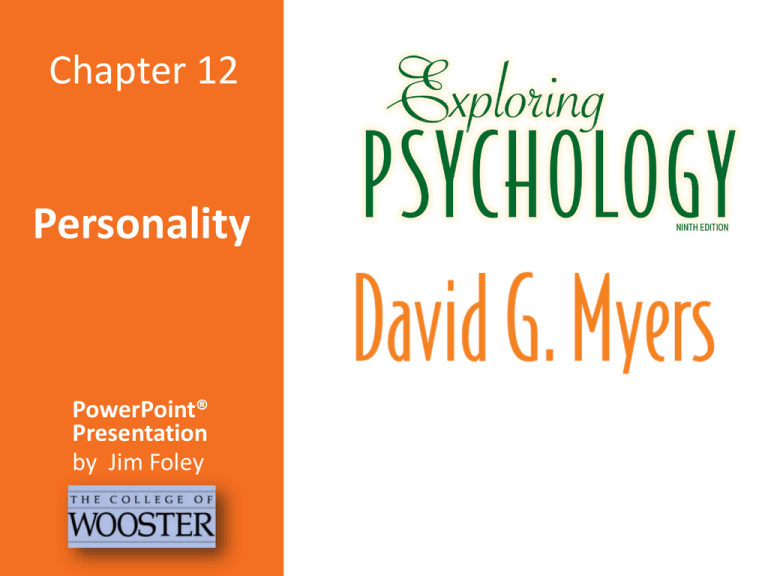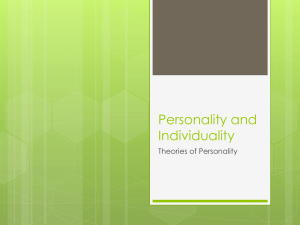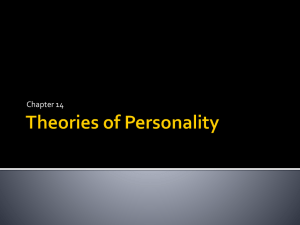exppsych9e_lppt_12 - Forensicconsultation.org
advertisement

Chapter 12 Personality PowerPoint® Presentation by Jim Foley Overview: Ways of Looking at the Self Freudian/Psychodynamic views: the Unconscious parts of the self Humanistic view of the Self-Actualizing Person Examining Traits, including the Big Five Factors/Dimensions Social and Cognitive Influences on Personality Self-Esteem and Self-Serving Bias These different perspectives and concepts can help us examine: What we have in common: personality components, basic drives, stages of development, categories of traits Ways in which we differ: individual paths through stages, ways of managing basic drives and needs, levels of Trait dimensions Psychodynamic Theories of Personality Bringing out the Unconscious Part of Your Personality Freud and the Psychoanalytic on: Personality Structure: id, ego, superego Personality Development: Psychosexual Stages Defense Mechanisms The Neo-Freudian, Psychodynamic theorists: from sexual to social issues Assessing Unconscious Processes: Projective Tests. Modern ideas about the unconscious and other Freudian concepts Personality: An individual’s characteristic patterns of thoughts, feelings, and behaviors [persisting over time and across situations] Agreeable, Open Introverted Naïve Sensitive, Reactive Contentedly lethargic Neurotically Conscientious irritable Psychodynamic/Psychoanalytic Theories These theories of human personality focus on the inner forces that interact to make us who we are. In this view: behavior, as well as human emotions and personality, develop in a dynamic (interacting, changing) interplay between conscious and unconscious processes, including various motives and inner conflicts. Freud’s Path to Developing Psychonalysis Sigmund Freud started his career as a physician. He decided to explore how mental and physical symptoms could be caused by purely psychological factors. He became aware that many powerful mental processes operate in the unconscious, without our awareness. This insight grew into a theory of the structure of human personality and its development. His name for his theory and his therapeutic technique: psychoanalysis. Psychoanalysis: Techniques Techniques for revealing the unconscious mind: He used creative techniques such as free association: encourage the patient to speak whatever comes to mind, The therapist then interprets any potential unconscious wishes hidden in the client’s hesitations, slips of the tongue, and dreams. Freud’s Personality/Mind Iceberg The mind is mostly below the surface of conscious awareness Personality develops from the efforts of our ego, our rational self, to resolve tension between our id, based in biological drives, and the superego, society’s rules and constraints. The Unconscious, in Freud’s view: A reservoir of thoughts, wishes, feelings, and memories, that are hidden from awareness because they feel unacceptable. The Developing Personality We start life with a personality made up of the id, striving impulsively to meet basic needs, living by “the pleasure principle.” In a toddler, an ego develops, a self that has thoughts, judgments, and memories following a “reality principle” The ego works as the “executive” of this three-part system, to manage bodily needs and wishes in a socially acceptable way. Around age 4 or 5, the child develops the superego, a conscience internalized from parents and society, following a “morality principle.” Freud’s Theory of Psychosexual Stages The id is focused on the needs of erogenous zones, sensitive areas of the body. People feel shame about these needs and can get fixated at one stage, never resolve how to manage the needs of that zone’s needs. Male Development Issues Freud believed that as boys in the phallic stage seek genital stimulation, they begin to develop unconscious sexual desires for their mothers and hate their father as a rival, feeling guilt and fearing punishment by castration. He named these feelings “the Oedipus complex,” after a story from Greek mythology. Resolution of this conflict: Boys identify with their fathers rather than seeing them as a rival. Defending Against Anxiety Freud believed that we are anxious about our unacceptable wishes and impulses, and we repress this anxiety with the help of the strategies below. Which Defense Mechanism Am I? A politician gives anti-gay speeches, then turns out to have homosexual tendencies. Reaction Formation Someone with an anger problem accuses everyone else of being angry and threatening. Projection These two are sometimes confused with each other. The common theme, as with all defense mechanisms: they seek to prevent being conscious of unacceptable feelings. The difference: the first one compensates, the second one distracts. Neo-Freudian, Psychodynamic Theorists Psychodynamic theorists, such as Adler, Horney, and Jung, accepted Freud’s ideas about: The importance of the unconscious and childhood relationships in shaping personality The id/ego/superego structure of personality The role of defense mechanisms in reducing anxiety about uncomfortable ideas Psychodynamic theorists differed from Freud in a few ways: Adler and Horney believed that anxiety and personality are a function of social, not sexual tensions in childhood Jung believed that we have a collective unconscious, containing images from our species’ experiences, not just personal repressed memories and wishes The Psychodynamic Theorists Carl Jung Alfred Adler Karen Horney Highlighted universal themes in the unconscious as a source of creativity and insight. Found opportunities for personal growth by finding meaning in moments of coincidence. Focused on the fight against feelings of inferiority as a theme at the core of personality, although he may have been projecting from his own experience. Criticized the Freudian portrayal of women as weak and subordinate to men. She highlighted the need to feel secure in relationships. Assessing the Unconscious: Psychodynamic Personality Assessment Freud tried to get unconscious themes to be projected into the conscious world through free association and dream analysis. Projective tests are a structured, systematic exposure to a standardized set of ambiguous prompts, designed to reveal inner dynamics. Rorschach test: “what do you see in these inkblots?” Problem: Results don’t link well to traits (low validity) and different raters get different results (low reliability). Unfalsifiability: He developed theories that are hard to prove or disprove: can we test to see if there is an id? Unrepresentative Post facto explanations sampling: (hindsight bias) He did not build his Flaws in rather than theories on a broad predictions: sample of Freud’s Whether or not a observations; he scientific situation makes you described all of anxious or not, you humanity based on method could either be people with unusual fixated or psychological repressing. problems. Biased observations: He based theories on his patients, which may give him an incentive to see them as unwell before his treatment. Evidence has Updated Freud’s Ideas Development appears to be lifelong, not set in stone by childhood. Infant neural networks are not mature enough to create a lifelong impact of childhood trauma. Peers have more influence on personality, and parents less, than Freud assumed. Dreams, as well as slips of the tongue, have many possible origins, less likely to reveal deep unconscious conflicts and wishes. We may ignore threatening information, but traumatic memories are usually intensely remembered, not repressed. Still, sexual abuse stories are more likely to be fact, less likely to be wish fulfillment, than Freud thought. Gender and sexual identity seems to be more a function of genetics than Oedipus conflicts and relationships with parents. The Unconscious As Seen Today: Processing, Perceptions, and Priming, But Not a Place Unconscious: a stream, not a reservoir The following processes operate at an unconscious level, not because they’re repressed, but because they are automatic: Schemas guide our perceptions Right hemisphere makes choices the left hemisphere doesn’t verbalize Conditioned responses, learned skills and procedures, all guide our actions without conscious recall Emotions get activated Stereotypes influence our reactions Priming affects our choices Freud’s Legacy Freud benefitted psychology, giving us ideas about: the impact of childhood on adulthood, human irrationality, sexuality, evil, defenses, anxiety, and the tension between our biological selves and our socialized/civilized selves. Freud gave us specific concepts we still use often, such as ego, projection, regression, rationalization, dream interpretation, inferiority “complex,” oral fixation, sibling rivalry, and Freudian slips. Not bad for someone writing over 100 years ago with no technology for seeing inside the brain. Developing a Healthy, Genuine Human Personality Maslow: Becoming a selfactualized person Rogers: Growing, in a social environment of: Genuineness Acceptance Empathy Assessing the self Evaluating Humanistic Theories: What about Evil? Too much individualism? Humanistic Theories of Personality Abraham Maslow Carl Rogers In the 1960’s, some psychologists began to reject: the dehumanizing ideas in Behaviorism, and the dysfunctional view of people in Psychodynamic thought. Maslow and Rogers sought to offer a “third force” in psychology: The Humanistic Perspective. They studied healthy people rather than people with mental health problems. Humanism: focusing on the conditions that support healthy personal growth. Maslow: The Self-Actualizing Person In Maslow’s view, people are motivated to keep moving up a hierarchy of needs, growing beyond getting basic needs met. At the top of this hierarchy are self-actualization, fulfilling one’s potential, and self-transcendence. In this ideal state, a personality includes being self-aware, selfaccepting, open, ethical, spontaneous, loving caring, focusing on a greater mission than social acceptance. Rogers’ Person-Centered Perspective Rogers agreed that people have natural tendencies to grow, become healthy, and move toward self-actualization. The three conditions that facilitate growth (just as water, nutrients, and light facilitate the growth of a tree): Genuineness: Being honest, direct, not using a façade Acceptance, a.k.a Unconditional Positive Regard: acknowledging feelings without passing judgment; Empathy: tuning into the feelings of others, showing your efforts to understand, listening well Assessing the Self in Humanistic Psychology: Ideal Self vs. Actual Self In the humanistic perspective, the core of personality is the self-concept, our sense of our nature and identity. People are happiest with a self-concept that matches their ideal self. Thus, it is important to ask people to describe themselves as they are and as they ideally would like to be. • Questionnaires can be used, but some prefer open interview. • Questions about actual self: How do you see yourself? What are you like? What do you value? What are you capable of? • If the answers do not match the ideal, selfacceptance may be needed, not just self-change. Critiquing the Humanist Perspective What about evil? Some say Rogers did not appreciate the human capacity for evil. Rogers saw “evil” as a social phenomenon, not an individual trait: “When I look at the world I’m pessimistic, but when I look at people I am optimistic.” –Rogers Humanist response: Selfacceptance is not the end; it then allows us to move on from defending our own needs to loving and caring for others. Critiquing the Humanist Perspective Too much self-centeredness? Some say that the pursuit of selfconcept, an accepting ideal self, and self-actualization encouraged not selftranscendence but selfindulgence, self-centeredness. Humanist response: The therapist using this approach should not encourage selfishness, and should keep in mind that that “positive regard” means “acceptance,” not “praise.” Trait Theories, Social-Cognitive Theories, and the Self Getting you to think about the qualities you may see in yourself: Traits: Stable components of personality • Dimensions and factors • Assessing traits: MMPI • The 5 “CANOE” factors • The impact of traits on situations & vice versa Social-Cognitive influences on personality • Reciprocal Determinism among thoughts, social situation, behavior • Internal vs. external locus of control • Optimism and positive psychology The Self: Spotlight effect, Self-Esteem, Self-serving bias Personality As Seen in Palms and Stars And handwriting, and crystal balls, and tea leaves, and scattered bones By saying something that is vague and likely to be true of you, then following up on comments that you reinforce by nodding, someone can appear to see into your soul. You too can turn your keen sense of the obvious into a career in predicting the present! I see by your handwriting you like bananas. Trait Theory of Personality Gordon Allport decided that Freud overvalued unconscious motives and undervalued our real, observable personality styles/traits. Myers and Briggs wanted to to study individual behaviors and statements to find how people differed in personality: having different traits. The Myers-Briggs Type Indicator (MBTI) is a questionnaire categorizing people by traits. Trait: An enduring quality that makes a person tend to act a certain way. Examples: “honest.” “shy.” “hard-working.” MBTI traits come in pairs: “Judging” vs. “Perceiving.” “Thinking” vs. “Feeling.” Trait theory of personality: That we are made up of a collection of traits, behavioral predispositions that can be identified and measured, traits that differ from person to person Traits: Rooted in Biology? Brain: Extraverts tend to have low levels of brain activity, making it hard to suppress impulses, and leading them to seek stimulation. Body: The trait of shyness appears to be related to high autonomic system reactivity, an easily triggered alarm system. Genes: Selective breeding of animals seems to create lifelong differences in traits such as aggression, sociability, or calmness, suggesting genetic roots for these traits. Factor Analysis and the Eysencks’ Personality Dimensions Factor Analysis: Identifying factors that tend to cluster together. Using factor analysis, Hans and Sybil Eysenck found that many personality traits actually are a function of two basic dimensions along which we all vary. Research supports their idea that these variations are linked to genetics. Assessing Traits: Questionnaires Personality Inventory: Questionnaire assessing many personality traits, by asking which behaviors and responses the person would choose Empirically derived test: all test items have been selected to because they predictably match the qualities being assessed. Minnesota Multiphasic Personality Inventory (MMPI): Designed to identify people with personality difficulties T/F questionnaire; items were selected because they correlated with various traits, emotions, attitudes Example: depressed people tend to answer “true” to: “Nothing in the paper interests me except the comics.” Sample MMPI Test Profile The “Big Five” Personality Factors The Eysencks felt that people Conscientiousness: varied along two dimensions. self-discipline, careful Current cross-cultural research and pursuit of delayed theory supports the expansion goals from two dimensions to five Agreeableness: factors: helpful, trusting, friendliness to help us Neuroticism: anxiety, remember insecurity, emotional the five instability factors, Openness: flexibility, remember nonconformity, that the first variety letters spell Extraversion: “CANOE”… Drawing energy from others, sociability The “Big Five”/ C.A.N.O.E. Personality Dimensions Impulsive Trusting Anxious Conforming Fun-Loving Questions about Traits These topics are the subject of ongoing research: Stability: One’s distinctive mix of traits doesn’t change much over the lifespan. However, everyone in adulthood becomes: More conscientious and agreeable, and Less extraverted, neurotic/unstable, and less open (imaginative, flexible). Predictive value: Levels of success in work and relationships relates to traits such as openness and conscientiousness. Heritability: For most traits, genes account for 50% of the variation among individuals Change vs. Consistency: Shifts with Age Over years of development, we change interests, attitudes, roles, jobs, relationships; we develop skills, maturity. Do traits stay stable through all this change? The evidence shows that it takes time for personality to stabilize. Traits do change, but less and less so over time. We change less, become more consistent. Person-Situation Controversy Trait theory assumes that we have traits that are a function of personality, not situation. There is evidence that some traits are linked to roles and to personas we use in different cultures, environments. Personality Affecting the Situation, Not Just a Function of the Situation Your Facebook posts, your website, music lists, choice of ringtone--these all reflect your personality. These choices also may shape how others treat you, which may affect your personality. This room may reflect the personality of the guy who lives there. The setup and contents of the room may also shape his personality. Social-Cognitive Perspective Albert Bandura believes that Personality is: The result of an interaction that takes place between a person and their social context, involving how we think about ourselves and our situations. Questions raised in this perspective: How do we interpret and respond to external events? How do those responses shape us? How do our memories, expectations, schemas, influence our behavior patterns? How do the personality and social environment mutually influence each other? Reciprocal Influences in Becoming “The Kind of Person Who Does Rock Climbing” Reciprocal: a back and forth influence, with no primary cause Example: a tendency to enjoy risky behavior affects choice of friends, who in turn may encourage rock climbing, which may lead to identifying with the activity. Avoiding the highway today without identifying or explaining any fear: the “low road” of emotion. Reciprocal Determinism: How personality, thoughts, social environment all reinforce/cause each other Why is Jake a happy, smiley person? He may have started with an “easy” temperament; He may attract other happy people, and people are more likely to smile when around him, which reinforces his smiles; His mind fills in the reasons why he’s smiling even if some of it was a reflection of his happy friends, and these happy reasons give him more reason to smile. Evaluating Behavior in Situations: Blindness to One’s Own Faults Donald Trump as the host of “The Apprentice” prided himself on assessing executive skills in others. Assessments based on performance in such simulations predict future job performance better than interviews and questionnaires. Donald Trump as a politician could not understand why more people didn’t join his candidacy, his debates, his “birther” theories. Evaluating the Social-Cognitive Perspective The social-cognitive perspective on personality helps us focus on the interaction of behaviors, thoughts, and social situations. This focus, though, may distract us from noticing an individual’s feelings, emotions, inner qualities. Critics note that traits may be more a function of genetics and upbringing, not just situation. Example of two people with different reactions in the same situation: Two lottery winners sharing a jackpot; one sobbed, the other slept. Biopsychosocial Approaches to Personality Exploring the Self, Viewing the Self Research in personality includes the topic of a person’s sense of self. Topics of research include self-talk, self-esteem, selfawareness, selfmonitoring, self-control. The field has refined a definition of “self” as the core of personality, the organizer and reservoir of our thoughts, feelings, actions, choices, attitudes. Topics for our study of people’s sense of self: The Spotlight Effect (self-consciousness) Self-esteem, low and high, benefits and risks Self-Serving Bias Narcissism Self-disparagement Secure self-esteem Self-Consciousness: The Spotlight Effect Experiment: Students put on Barry Manilow T-shirts before entering a room with other students. (Manilow was not even cool “back in the day.”) Result: The students thought others would notice the T-shirt, assumed people were looking at them, when this was not the case; they greatly overestimated the extent to which the spotlight was on them. The spotlight effect: assuming that people are have attention focused on you when they actually may not be noticing you. Lesson: People don’t notice our errors, quirks, features, and shirts as much as we think they do. Self-Esteem: High and Low, Good and Bad People who have normal or high self-esteem, feeling confident and valuable, get some benefits: Increased resistance to conformity pressure Decreased harm from bullying Increased resilience and efforts to improve their own mood But maybe this “high” selfesteem is really realistic, and is a result, not a cause, of these successes. Low self-esteem, even temporarily lowered by insults, leads to problems: prejudice, being critical of others Self-Serving Bias We all generally tend to think we are above average. This bias can help defend our selfesteem, as it does for the people in this wheel. Self-Focus and Narcissism Since 1980, song lyrics have become more focused on the self, both gratification and self-praise. Empathy scores and skills are decreasing, being lost; people increasingly don’t bother trying to see things from the perspective of others. There is a rise in narcissism (self-absorption, selfgratification, inflated but fragile self-worth). Narcissists see themselves as having a special place in the world. Danger, especially in narcissism: When self-esteem is threatened, it can trigger defensive aggression. Preventing this aggressive defense of self-esteem: not raising self-esteem, but reinforcing it, having people state their own values and qualities Self-Disparagement, Self-Acceptance Left behind in the supposed increase in egotism: those who feel worthless, unlovable Some people have a habit of self-disparaging self-talk: “I’m no good. I’m going to fail.” Sometimes such remarks are a sign of depression or at least feeling inferior. Sometimes such remarks may elicit pity, or prepare us for possible bad events, or help us learn from mistakes (people are more critical of their past selves). Moving from defensive to secure self-esteem requires realistic expectations and self-acceptance. Culture and the Self: Individualism and Collectivism Individualist cultures value independence. They promote personal ideals, strengths, and goals, pursued in competition with others, leading to individual achievement and finding a unique identity. Collectivist cultures value interdependence. They promote group and societal goals and duties, and blending in with group identity, with achievement attributed to mutual support. Individualist and Collectivist Cultures Compared Thinking about the self: Cultural differences People in collectivist cultures (those which emphasize group unity, allegiance, and purpose over the wishes of the individual) do not make the same kinds of attributions: 1. The behavior of others is attributed more to the situation; also, 2. Credit for successes is given more to others, 3. Blame for failures is taken on oneself.









